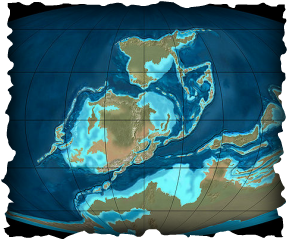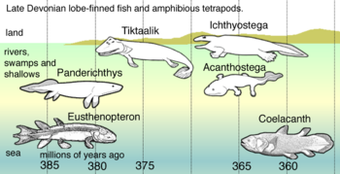Devonian Time Period

Continent placement during the Devonian
During the Devonian time period the climate was relatively warm; there probably weren't any glaciers during this time period.
The time period is named after Devon, England, where the type of rocks from this period were first studied. The Devonian time period is known by a few other names; such as "The Age of Fishes", "Old Red Age", and also as a "greenhouse age". The reason why the Devonian time period is called "the age of fishes" is because of the diverse, abundant, and somewhat weird types of fish that existed during this period in time. During the end of the Devonian period the first forests began to grow.
Up to 70% of the organisms during this time became extinct at the end of the period; a few theories of how the extinction became are global cooling, reduced atmospheric levels of the greenhouse gas carbon dioxide, or a huge meteor impact on Earth, which are all likely to had happened. The global cooling would have came from the re-glacier of the land mass Gondwana, and for the reducing of the atmospheric levels of greenhouse gas carbon dioxide would have came from the foresting of the continents.
The time period is named after Devon, England, where the type of rocks from this period were first studied. The Devonian time period is known by a few other names; such as "The Age of Fishes", "Old Red Age", and also as a "greenhouse age". The reason why the Devonian time period is called "the age of fishes" is because of the diverse, abundant, and somewhat weird types of fish that existed during this period in time. During the end of the Devonian period the first forests began to grow.
Up to 70% of the organisms during this time became extinct at the end of the period; a few theories of how the extinction became are global cooling, reduced atmospheric levels of the greenhouse gas carbon dioxide, or a huge meteor impact on Earth, which are all likely to had happened. The global cooling would have came from the re-glacier of the land mass Gondwana, and for the reducing of the atmospheric levels of greenhouse gas carbon dioxide would have came from the foresting of the continents.
Palaeospondylus Gunni
The Palaespondylus Gunni fossil was found in 1890, by two cousins named Gunni; it was found primarily in Caithness, Scotland. The Palaespondylus Gunni is a rare fossil; only found a few other times in nearby locations. It's minute in size, and has a structure unlike most other fish. Recent studies show that the Palaespondylus Gunni is a Dipterus, which resembles today's lungfish, but went through serious metamorphosis. Scientists were bemused by this fossil; they have concluded that the Palaespondylus was a larval lungfish. The Palaespondylus Gunni is an unique example of the early fish on earth.
Osteolepis
The Osteolepis fish are an extinct type of lobe-finned fish; they're related to the famous, "the living fossil", Coelacanth. They lived in the Orcadian Lakes of northern Scotland. The Osteolepis fish were almost 8 in. long (20 cm.), and had big square scales on them. They, also, had common features with tetrapods.
Goniatite Ammonites
The Goniatite Ammonites are related to the squid, octopus, and belemnites, which all form the class Goniatitida. They were cephlopods, and usually were in the deeper parts of water. Goniatite Ammonites were one of the new species found in the Devonian time period; they were also abundant. Goniatite Ammonites survived the Late Devonian extinction, but they became extinct at the end of the Permian time period. They can be found in: North America, Europe, North Africa, and Australasia. Goniatite fossils may be used as index fossils, which helps in dating the rock layer they're found in.
Tiktaalik
The Tiktaalik "fish" are another example of lobe-finned "fish", and have a lot in common with tetrapods. They came from the late Devonian time period, but became extinct in the end of the Cretaceous time period. They are one of the first known fishes with a neck; they, also, had primitive lungs and gills, which were useful in shallow waters.
Coelacanth
"The Living Fossil"

Late Devonian Vertabraes
The Coelacanth fish, which means "hollow fish", is a famous fish species, that is known as "the living fossil", because they were thought to be extinct for nearly 80 million years. They are related to the lung-fish and the tetrapods. In 1938, one of them was caught in a net with other kinds of fish in the Indian Ocean. Soon, after that, a local chemistry professor confirmed that it was an important discovery. Then, in 1952, another fish was caught in the Comoros Islands; many other coelacanth fishes have been obtained in near areas. Later, it was found out that the fishes were known about by the islanders; who ate the fish dried with salt. Then, in 1998, a second discovery of the type of fish was found in Indonesia. In my personal opinion, I think that they're a kinda ugly looking fish... Let the pictures below explain my thoughts.
Site References
"Fossil Fish from the Paleozoic Era." Fossil Mall Fossils for Sale.
Thurs. 22 Sept. 2011. http://www.fossilmall.com/Science/paleozoic-fish-fossils.htm
"Devonian Period." Encyclopædia Britannica. Encyclopædia Britannica Online. Encyclopædia Britannica, 2011.
Web. 27 Sep. 2011. http://www.britannica.com/EBchecked/topic/160322/Devonian-Period.
"Goniatite." Wikipedia. Last updated on 26 January 2011.
Tues. 27 Sept. 2011. http://en.wikipedia.org/wiki/Goniatitida
"Tiktaalik." Wikipedia. Last updated on 21 September 2011.
Tues. 27 Sept. 2011. http://en.wikipedia.org/wiki/Tiktaalik
"Coelacanth." Wikipedia. Last updated on 21 September 2011.
Tues. 27 Sept. 2011. http://en.wikipedia.org/wiki/Coelacanth#Discovery
"Coelacanth." Encyclopædia Britannica. Encyclopædia Britannica Online.
Encyclopædia Britannica, 2011. Web. 27 Sep. 2011. http://www.britannica.com/EBchecked/topic/124128/coelacanth.
"Osteolepis." Wikipedia. Last updated on 14 September 2010.
Tues. 27 Sept. 2011. http://en.wikipedia.org/wiki/Osteolepis
Thurs. 22 Sept. 2011. http://www.fossilmall.com/Science/paleozoic-fish-fossils.htm
"Devonian Period." Encyclopædia Britannica. Encyclopædia Britannica Online. Encyclopædia Britannica, 2011.
Web. 27 Sep. 2011. http://www.britannica.com/EBchecked/topic/160322/Devonian-Period.
"Goniatite." Wikipedia. Last updated on 26 January 2011.
Tues. 27 Sept. 2011. http://en.wikipedia.org/wiki/Goniatitida
"Tiktaalik." Wikipedia. Last updated on 21 September 2011.
Tues. 27 Sept. 2011. http://en.wikipedia.org/wiki/Tiktaalik
"Coelacanth." Wikipedia. Last updated on 21 September 2011.
Tues. 27 Sept. 2011. http://en.wikipedia.org/wiki/Coelacanth#Discovery
"Coelacanth." Encyclopædia Britannica. Encyclopædia Britannica Online.
Encyclopædia Britannica, 2011. Web. 27 Sep. 2011. http://www.britannica.com/EBchecked/topic/124128/coelacanth.
"Osteolepis." Wikipedia. Last updated on 14 September 2010.
Tues. 27 Sept. 2011. http://en.wikipedia.org/wiki/Osteolepis
